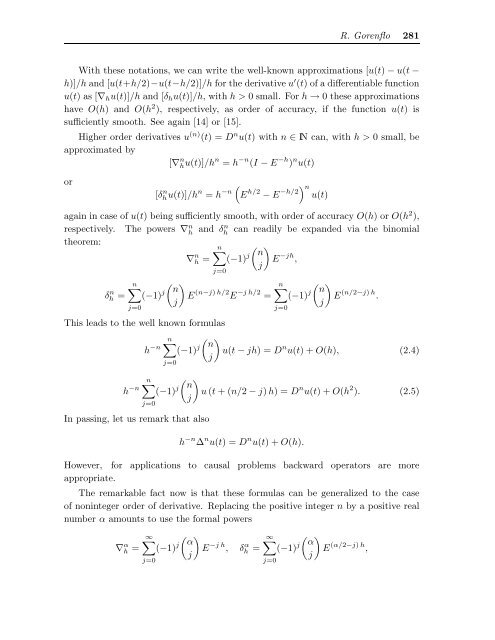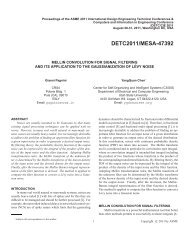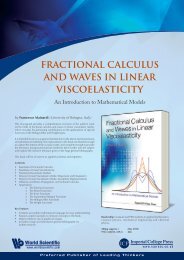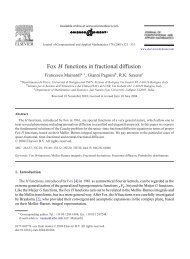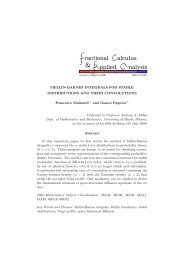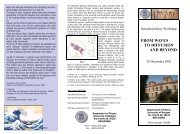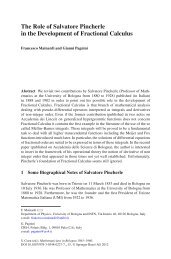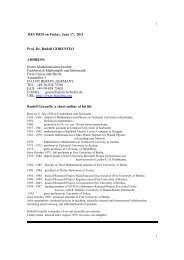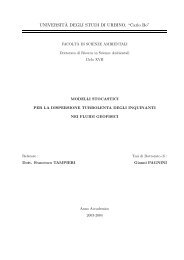CISM LECTURE NOTES International Centre for Mechanical Sciences
CISM LECTURE NOTES International Centre for Mechanical Sciences
CISM LECTURE NOTES International Centre for Mechanical Sciences
Create successful ePaper yourself
Turn your PDF publications into a flip-book with our unique Google optimized e-Paper software.
R.Gorenflo 281<br />
With these notations, we can write the well-known approximations [u(t) − u(t −<br />
h)]/h and [u(t+h/2)−u(t−h/2)]/h <strong>for</strong> the derivative u ′ (t) of a differentiable function<br />
u(t) as[∇hu(t)]/h and [δhu(t)]/h, withh>0 small. For h → 0 these approximations<br />
have O(h) and O(h2 ), respectively, as order of accuracy, if the function u(t) is<br />
sufficiently smooth. See again [14] or [15].<br />
Higher order derivatives u (n) (t) =Dnu(t) withn∈IN can, with h>0 small, be<br />
approximated by<br />
[∇ n hu(t)]/hn = h −n (I − E −h ) n u(t)<br />
or<br />
[δ n h u(t)]/hn = h −n<br />
<br />
E h/2 − E −h/2<br />
n u(t)<br />
again in case of u(t) being sufficiently smooth, with order of accuracy O(h) orO(h2 ),<br />
respectively. The powers ∇n h and δn h can readily be expanded via the binomial<br />
theorem:<br />
∇ n h =<br />
n<br />
(−1) j<br />
<br />
n<br />
E<br />
j<br />
−jh ,<br />
δ n h =<br />
n<br />
(−1) j<br />
j=0<br />
j=0<br />
<br />
n<br />
E<br />
j<br />
(n−j) h/2 E −jh/2 n<br />
=<br />
j=0<br />
(−1) j<br />
<br />
n<br />
E<br />
j<br />
(n/2−j) h .<br />
This leads to the well known <strong>for</strong>mulas<br />
h −n<br />
n<br />
(−1) j<br />
<br />
n<br />
u(t − jh)=D<br />
j<br />
n u(t)+O(h), (2.4)<br />
h −n<br />
j=0<br />
j=0<br />
In passing, let us remark that also<br />
n<br />
(−1) j<br />
<br />
n<br />
u (t +(n/2 − j) h) =D<br />
j<br />
n u(t)+O(h 2 ). (2.5)<br />
h −n ∆ n u(t) =D n u(t)+O(h).<br />
However, <strong>for</strong> applications to causal problems backward operators are more<br />
appropriate.<br />
The remarkable fact now is that these <strong>for</strong>mulas can be generalized to the case<br />
of noninteger order of derivative. Replacing the positive integer n by a positive real<br />
number α amounts to use the <strong>for</strong>mal powers<br />
∇ α h =<br />
∞<br />
(−1) j<br />
<br />
α<br />
E<br />
j<br />
−jh , δ α h =<br />
j=0<br />
∞<br />
(−1) j<br />
<br />
α<br />
E<br />
j<br />
(α/2−j) h ,<br />
j=0


